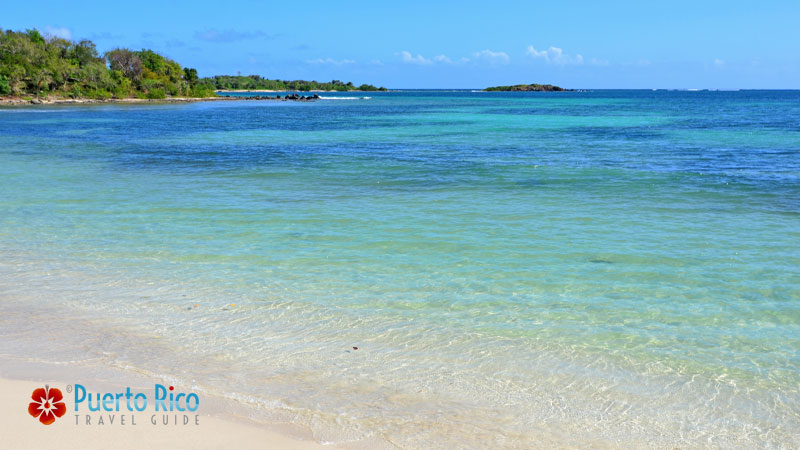Puerto Rico ⎮ Puerto Rico Travel Guide ⎮ Puerto Rico Weather
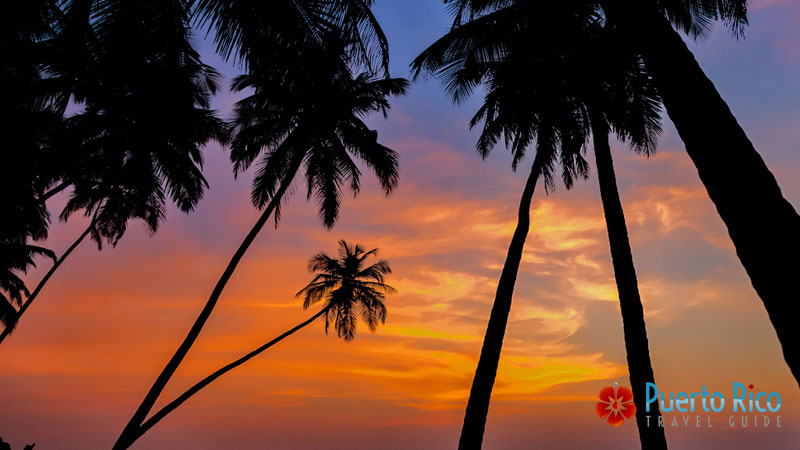
Guide for tourists from an islander’s perspective… What is the weather really like in Puerto Rico, and what does it mean for your travels? When is hurricane season, the best time to snorkel, and more.
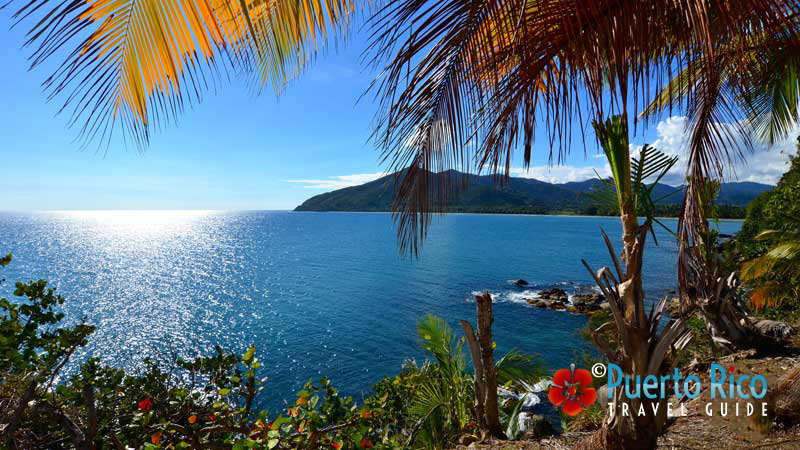
Read on, we’ll tell you what the weather is like from a local’s perspective, along with great tips on enjoying Puerto Rico rain or shine. This weather guide is not written by a meteorologist, just two Puerto Rico lovers, that love blue skies and great weather. We take all the photos on this travel guide, so we have learned by trial and error how to get around the rain and head to the sunshine for those blue skies. We do love the rain, and we often find something to do when it does. If you happen to be here during a rainy afternoon, don’t worry, it rarely lasts long enough to ruin your day, the plus side is that you’ll see more dramatic and deep colors on the sunsets on the west coast.
10-day Weather Forecast
Capital City of San Juan - Puerto RicoWorld Class Award-Winning Tours in Puerto Rico
Live Puerto Rico Weather Radar
The capital city of San Juan is located in the northeast, directly in the center of the radar map box below, at the top/north end of the red highway line. Just east of the main island are the Puerto Rico islands of Culebra and Vieques, and farther east, the British & U.S. Virgin Islands. The largest Puerto Rico island west is Mona Island.

Frequently Asked Questions - Weather in Puerto Rico
What is Puerto Rico’s Average Weather?
Overall, the temperatures are steady throughout the entire island. Puerto Rico’s climate, is part of the tropical climatic zone. In general, residents and visitors enjoy warm temperatures all year round averaging 80 °F (27 °C) in lower elevations and 70 °F (21 °C) in the lush central mountains of the main island of Puerto Rico. Most of the year, the weather is simply perfect. Because Puerto Rico is a tropical island, quick changes may occur from one week to the next. There are some differences in weather conditions among some regions of the main island and the offshore islands of Vieques & Culebra. Before you travel, be sure to check for weather alerts.
When is Puerto Rico’s Rain Season?
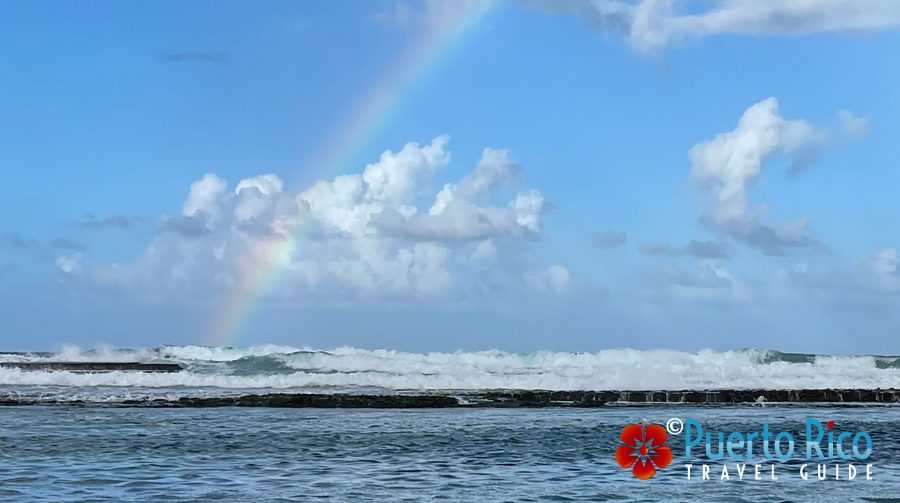
While most people leave when it starts raining, we wait.. hoping to see a raiinbow… Captured with IPhone
The rain season in Puerto Rico is from April to November, but don’t let that deter you from coming to the island during this season. Hotel rates tend to be lower at this time of year, you’ll find amazing deals at top beachfront hotels and resorts that may not be in your budget during the high season in the winter months.
Rain showers are typically scattered in the afternoons and don’t last very long. The variations in temperature and rainfall are caused by the mountains in the center of the island. Most likely, rain in Puerto Rico won’t ruin your whole vacation day. For residents, beach time is summertime, during “rain season”.
Beating the rain
If you vacation in Puerto Rico during the rain season, our best advice is to get up as early as you can to enjoy the beach, rain typically starts early afternoon. What’s great about Puerto Rico is that it rarely rains all over the island at the same time, it may be raining in one region, and in a half-hour drive, you will arrive at another destination with bright blue skies, you can download the FREE World Radar App, we use it all the time during the rainy season to see where to go on a rainy day. The southwest of the island gets less rain during the rainy season, however, the town of Mayaguez gets rain almost daily.
What are the hottest months in Puerto Rico?
The hottest months are July and August, but they’re also some of the best months to enjoy the beaches of Puerto Rico. Generally, Puerto Rico is breezy, and not very humid, even on a super hot day, breezes make the heat pleasantly enjoyable. Of course, the best way to beat the heat is by jumping into our beautiful waters. There’s about a 6 °F (3.3 °C) temperature change between winters and summer.
Hurricane Season in Puerto Rico
Hotels are open, and tourist activities are just as fun. A few small hotels and inns, especially on the islands of Vieques & Culebra close the hotel in the months of September through October to make renovations and major maintenance. Summer is actually the high season for residents since school age children are off school. Some of the best vacation deals are during this time of the year with hotels and airlines trying to fill up rooms and seats during this low travel season.
Historically, unlike Florida, Puerto Rico only gets hit by major storms and hurricanes many years apart. The majority of storms and hurricanes have taken place in the month of September.
Tips when traveling in hurricane season
- Purchase travel insurance just in case.
- Check the forecast closely a week before traveling in hurricane season.
- If you want to play it safest, head to the west coast of Puerto Rico. Tropical storms and hurricanes typically come in from the east, but the west coast sees less rain and damage than the rest of the island.
Important Sources of Information
- Flood Zone Areas and Shelter Information
- Red Cross
- Puerto Rico State Agency for Emergency and Disaster Management
- Police Department
- The Puerto Rico Tourism Company offices are open to help you with anything you might need during your stay. Visitors can call the Puerto Rico Tourism Company hotline at 877-976-2400
Hurricane History in Puerto Rico
Major hurricanes to hit Puerto Rico
- Hurricane Maria – On September 20th, Puerto Rico, Hurricane Maria entered the island as a Category 5, moved across the center of the island as a Category 4 causing catastrophic damage to this beautiful land. Although the official death toll is still being debated, hundreds of lives were lost as a direct results of the hurricane and many more died from the lack of power and basic necessary needs as a result of the damage to the infrastructure on the island. Thousands of people lost their home and their businesses. Tourism after Hurricane Maria update.
- Hurricane Irma – On September 6, 2017, Hurricane Irma moved up north as it approached the main island of Puerto Rico, saving the island from what could have been a catastrophic situation. Tropical storm winds hit the island, the islands of Vieques & Culebra felt the most impact as it passed closer to land. Culebra suffered the most damage, leaving many homes destroyed and residents homeless. About 70 percent of the island was without power and about 17 percent without water. Gov. Ricardo Rosselló made efforts to prepare the island’s residents, preparing hundreds of shelters in order to protect the most vulnerable. Puerto Rico was largely untouched when compared to the unfortunate devastation of neighboring islands of St. Martin, Barbuda & Cuba among others.
- Hurricane George, the first major hurricane to hit the island in over 60 years, a Category 3 in September of 1998.
- Two major hurricanes prior to George were four years apart: San Felipe II, one of the most intense hurricanes in Puerto Rico’s history on September 13, 1928; San Ciprián occurred on September 26-27 of 1932.
List of Hurricanes that affected Puerto Rico
- 2017 – Hurricane Maria – A category 5 hit Puerto Rico, the biggest hurricane to hit the island in almost a century.
- 2017 – Hurricane Irma – Irma passed 50 miles north of Puerto Rico. The island of Culebra suffered the most damage, destroying homes for many residents. Tropical winds from the storm left millions of residents without electricity.
- 2014 – Hurricane Cristobal – heavy rain, flooding of rivers, multiple landslides, about 17,000 residents lost power and about 7,000 residents without water.
- 2010 – Hurricane Earl – Heavy rain as Earl passed Puerto Rico. Roads were closed due to flooding. about 180,000 residents lost power and about 60,000 without water.
- 2000 – Hurricane Debby – A Category 1 hurricane – Puerto Rico got 12 inches of rainfall across Puerto Rico in 2 days, causing flooding, mudslides, damage to 406 homes, bridges and roads.
- 1998 – Hurricane Georges – Georges made landfall as a Category 3 near Fajardo on the eastern coast of Puerto Rico at 115 mph, the first major hurricane to hit the island in six decades. Georges caused 3.6 billion dollars in damage, there were no casualties directly related to the hurricane. Ten of thousands residents were left homeless, there were major damages to roads, agriculture and infrastructure due to heavy wind and rains and severe flooding.
- 1996 – Hurricane Hortense – Puerto Rico suffered about $153 billion in damage and about 19 lives lost mostly due to drowning from flash floods. About 1.4 million residents lost electricity.
- 1996 – Hurricane Bertha – heavy rainfall, damage to crops.
- 1989 – Hurricane Hugo – Damages exceeded 1 billion dollars. The east coast of Puerto Rico was hit hardest during Hurricane Hugo. Agricultural damage was severe and about 28,000 were left homeless. Due to flooding, a few roads and bridges were destroyed. There was a total of 12 deaths, half of victims lived in the town of Guayama; some were electrocuted by fallen power lines.
- 1988 – Hurricane Gilbert – Minor damage to agriculture, a few communities lost power.
- 1979 – Hurricane David – went south of Puerto Rico, did not land on the island. Hurricane created strong winds, heavy rain and strong seas. Most of the damage was to agriculture.
- 1979 – Hurricane Frederick – Category 4 – $5 million dollars in damage due to flooding.
- 1975 – Hurricane Eloise – Passed north of the island as a weak tropical storm, heavy rains caused severe flooding, causing the death of 34 people mostly from drownings. The town of Utuado took the major hit, four neighborhoods were totally under water, 6,000 had to leave their homes. Residents around the island head to the town of Utuado when the river water levels come down to get a glimpse of the towns that once existed.
- 1974 – Hurricane Carmen – passed Puerto Rico as a tropical storm creating moderate rainfall and flooding.
- 1966 – Hurricane Ines – This hurricane passed the south coast of Puerto Rico causing rain bands and gusty winds that reached 50 mph, causing flooding and 20 homes damaged from the wind.
- 1960 – Hurricane Donna – passed the north of Puerto Rico, severe flooding caused 107 fatalities, 85 of them in the municipality of Humacao on the eastern coast.
- 1956 – Hurricane Betsy – entered through southeast, moved across center of the island. About 15,000 homes were destroyed, the hurricane claimed 16 lives.
- 1932 – San Ciprian Hurricane – This Category 4 hurricane ravaged Puerto Rico from east to west, across the entire island.
- 1928 – Okeechobee hurricane – also known as the San Felipe Segundo hurricane, the only recorded hurricane to strike the island at Category 5 intensity until Hurricane Irma in 2017.
- 1899 – San Ciriaco hurricane – also known as 1899 Puerto Rico Hurricane, the deadliest tropical cyclone in the history of Puerto Rico. Most of the homes were constructed in wood, about 250,000 suffered, most of the crops were destroyed, residents were left without food and water. The hurricane claimed 3,369 lives.
- 1876 – San Felipe Hurricane
- 1867 – San Narciso Hurricane
- 1804 – Antigua–Charleston Hurricane – vessels were lost during the storms passage along the north.
- 1780 – The Great Hurricane of 1780 – also known as Huracán San Calixto & Great Hurricane of the Antilles, and the 1780 Disaster. The Great Hurricane of 1780 claimed the lives of over 20,000, the deadliest Atlantic hurricane on record.
Water Temperature in Puerto Rico
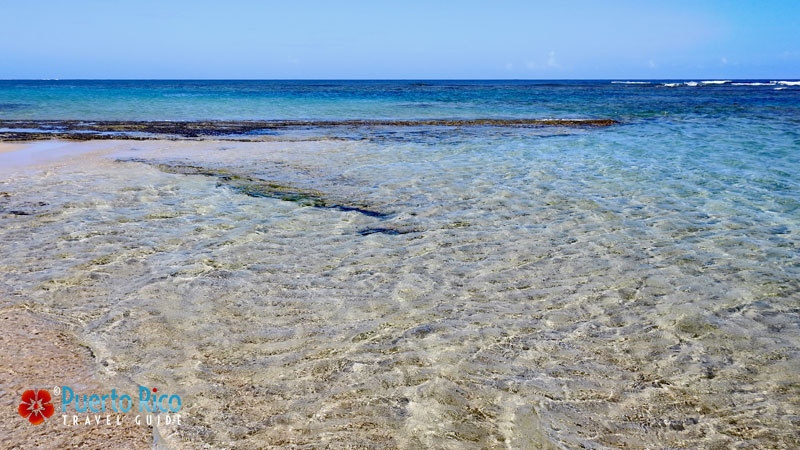
Best Snorkeling Weather Conditions in Puerto Rico
Culebra and Vieques have clear waters all year round, but in the summer months, they’re incredibly clear, warm, and calm with virtually no waves (during normal weather).
If you love snorkeling, the water is clearest and calmest during June, July, and August. Escambron Beach in San Juan, right in the capital city, is good all year round. Steps Beach in Rincon, one of the best surfing beaches, becomes one of the best snorkeling beaches during the summer months.
Top Rated Snorkeling Tours in Puerto Rico
Weather Differences Across Regions of Puerto Rico
When you do a search on Google for “Puerto Rico Weather”, Google shows you the weather in the capital city of San Juan. San Juan is located on the northeast coast of Puerto Rico which typically gets a little more rain than the southwest coast of Puerto Rico.
East Coast of Puerto Rico
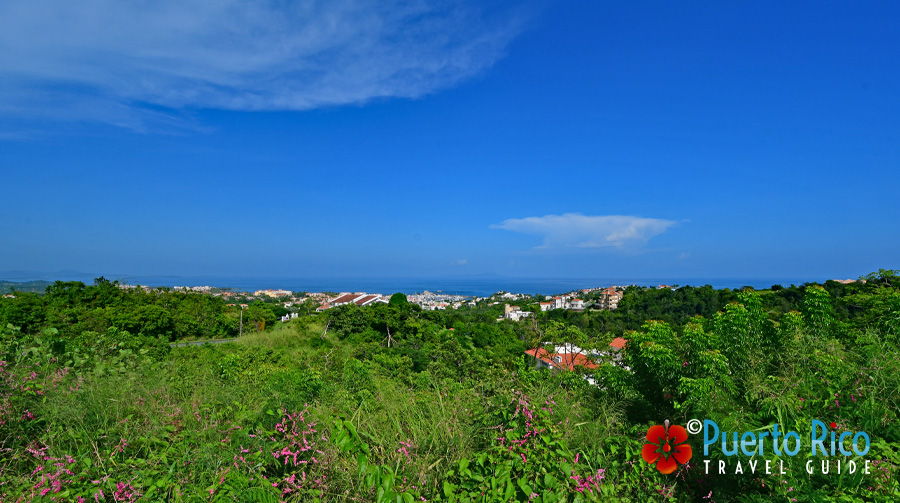
When the weather is “normal”, the east coast is a wonderful place to be. Compared to the rest of the island, it feels more breezy like the north coast. If you were unlucky to be here during a tropical storm, you’ll feel it more on the east coast of the island. Overall, the east offers beautiful tropical weather all year round under normal conditions.
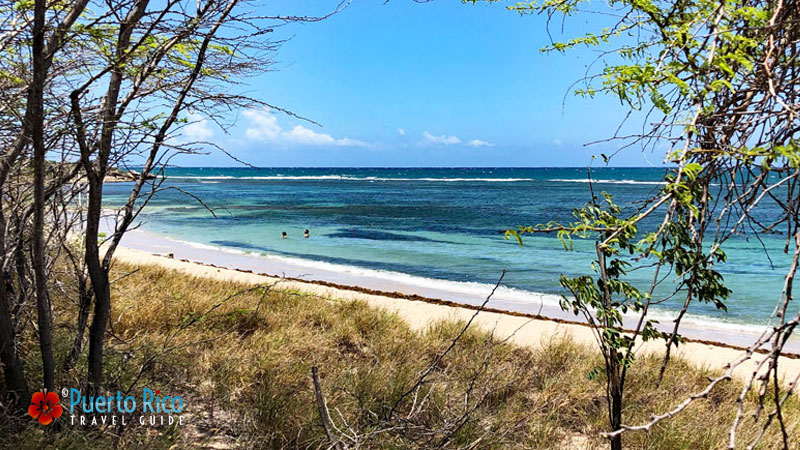
Temperatures are warmer in the southwest region of Puerto Rico with less rain. On the southwest, you’ll find the Guanica Biosphere Reserve (commonly known as the Guanica Dry Forest), which only gets about 29 inches of precipitation per year. The town of Cabo Rojo and Guanica is known for great weather all year round, dryer flora, and less rain than most places around the island. If you’re planning on traveling during hurricane season and want to play it safe, head to the west coast of Puerto Rico. Tropical storms and hurricanes typically come in from the east, the west coast sees less rain and damage when compared to the rest of the island. Again, the difference is not big enough to keep you from staying at the destination that appeals to you most, it only makes a difference during bad weather or a heavy rain season.
Moon Phase Calendar
If you plan on visiting one or more of the three Puerto Rico Bioluminescent Bays, use this interactive calendar to plan your trip around new moon phases, when it is darkest at night, so you can maximize your Bio Bay experience. Choose a month, year, then click “Go”.
Please visit this site for moon calendar.
Puerto Rico ⎮ Puerto Rico Travel Guide ⎮ Puerto Rico Weather Guide for Visitors – Best Times to Visit the Island

